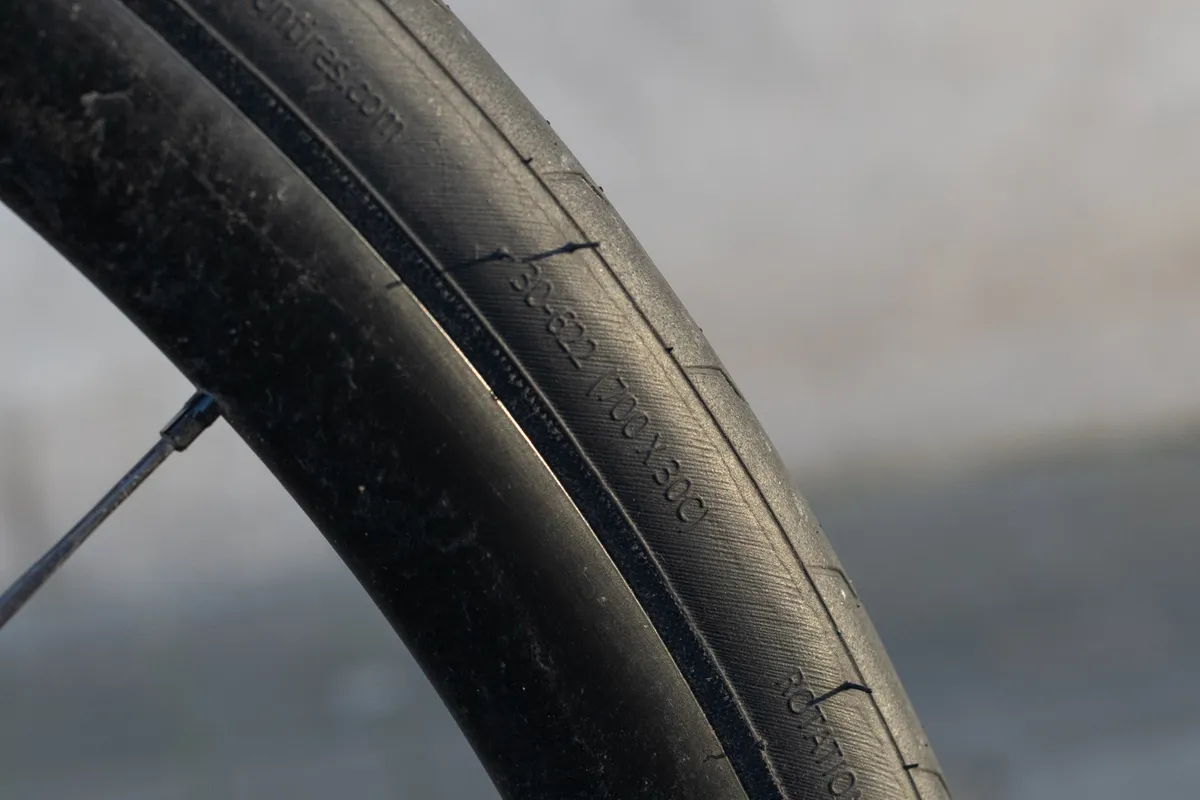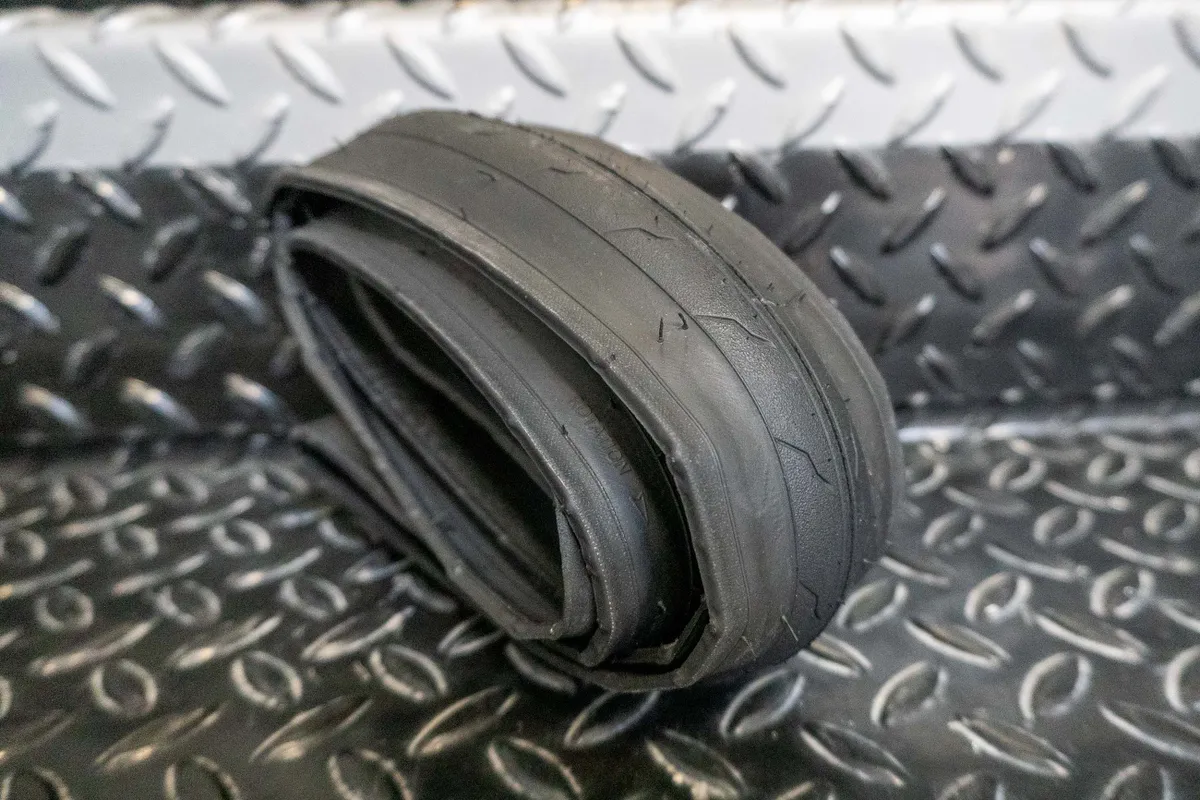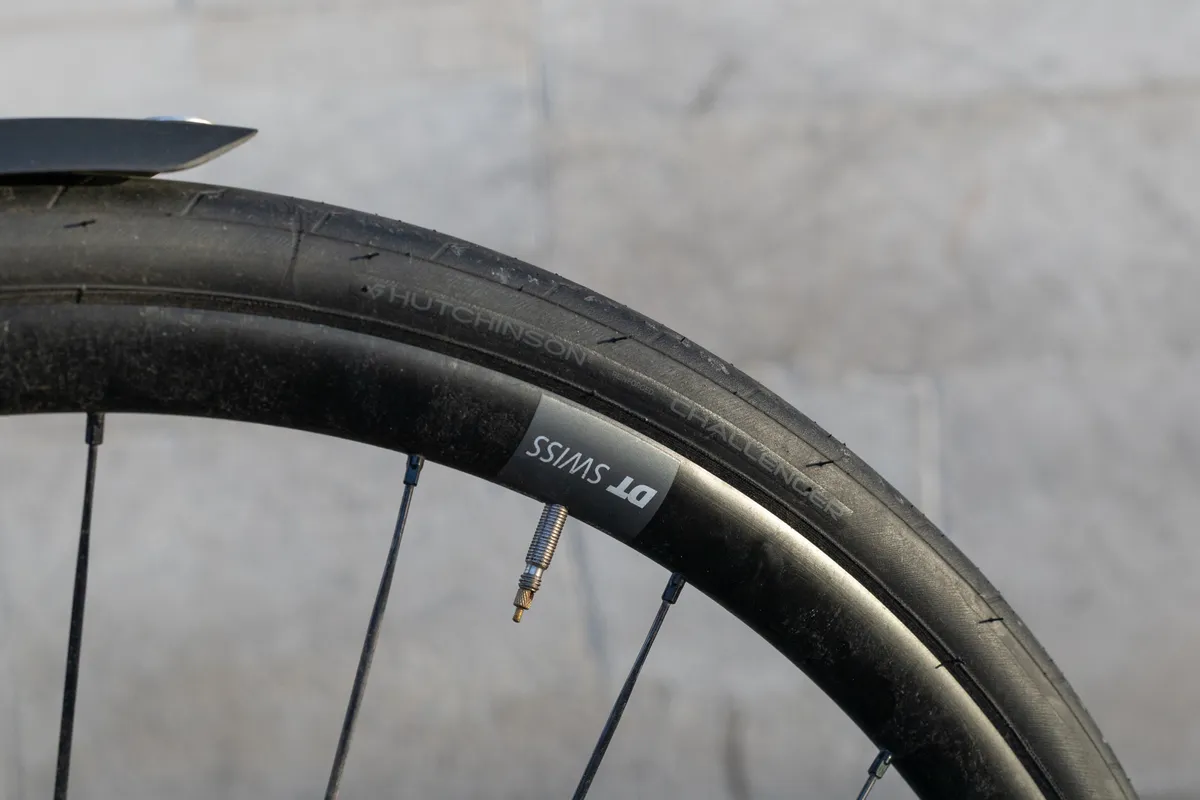The Hutchinson Challenger is dependable, grippy and an eye-poppingly cheap road bike tyre.
The French brand calls the Challenger a training and endurance tyre, but it doesn’t feel as slow as that mundane description suggests.
According to Hutchinson, the Challenger delivers high levels of comfort, durability and puncture resistance. However, it compromises performance and weight.
In all but name, the Challenger’s a winter road bike tyre. So how did it fare on wet and mucky roads littered with puncture traps?
Hutchinson Challenger details and specifications

Hutchinson says harder rubber in the middle of the Challenger defends against disastrous incisions, while the softer side compound ensures cornering traction.
The chevron-like pattern of the grooved tread, interspersed with dimples, augments grip, according to Hutchinson.
The French brand claims the Challenger’s high-density fibre reinforcement keeps punctures to a minimum and the tyre rolling for up to 8,000km.
The 66 TPI casing is designed to blend puncture protection with low weight and rolling resistance.
The rubber is thicker than on the brand’s other tyres such as the Hutchinson Fusion 5, a significantly lighter, racier option.
This brings the Hutchinson Challenger to 322g a tyre in the 700 x 30c size I tested – chunky compared to the best road bike tyres, but on par with its pricier competitors.
The Continental Grand Prix 4 Season weighs 289g in 700 x 28c and the Challenger’s claimed weight is 300g in the same size. In a 28mm width, the Pirelli Cinturato Velo is heavier at 360g.
You can buy two Challengers for the price of one Continental or Pirelli, underscoring the tyre’s keen value.
The Challenger also comes in 700 x 25c in black and 700 x 28c in black or tan sidewall.
Supporters of the #savetheinnertube campaign will delight in the Challenger being clincher-only. However, Hutchinson promises to release a tubeless version later this year.
I managed to install and remove the Challenger without resorting to tyre levers.
Hutchinson Challenger tyre performance

Without submitting the Hutchinson Challenger to rolling resistance testing, I can’t say definitively how much slower it is than a race tyre.
It doesn’t feel the slickest when accelerating and climbing. But once up to a decent speed on the flat, the Challenger isn’t noticeably draggy.
In my testing, the Challenger wasn’t a problem on pacy group rides. Average speeds are lower in winter. Plus, your club mates will probably prioritise puncture resistance over speed in their tyre choice as well.
It’s also hard to comment on the Challenger’s cornering credentials. Wary of slipping on greasy and gravel-covered bends, I don’t corner as aggressively in the winter as I do in summer.
However, when I was pushing on and leaning into turns, the Challenger had plenty of traction.
On really poor road surfaces and off-tarmac entirely, the lateral grip stopped my back wheel sliding. This can be a regular occurrence on faster, less tenacious tyres.
Off-road dabbling is admittedly a niche application for road bike tyres. But a tyre that’s capable on light gravel lends itself to all-road riding and bikepacking. Such versatility enhances the Challenger's value.
Despite forays onto broken byways, gravel tracks and loose canal towpaths, in 1,500 attritional kilometres I had only one puncture.
This came on a purely road ride. A sharp piece of flint embedded into the central tread just enough to cause a slow deflation of the inner tube.

The length of time I tested the Challenger wasn’t sufficient for me to comment on its long-term durability.
Over a few months, I’ve removed several pieces of detritus from the central tread, but nothing has threatened to pierce the casing – as you’d hope from a tyre designated for ultra-endurance cycling.
Endurance is a loose term in cycling, as the diversity of the best endurance road bikes exemplifies.
If your idea of endurance riding is a more leisurely paced audax, then the Hutchinson Challenger might fit the bill. The puncture protection suits self-supported riding.
But some endurance events involve covering long distances at a higher speed with a degree of mechanical support, for example in a sportive. In that case, you might get away with a faster, less resilient tyre, such as a Continental GP5000.
Another pitfall of running the Hutchinson Challenger on long rides is its lack of suppleness. The tyre doesn’t dull road buzz all that effectively.
After multiple hours in the saddle, this resulted in more wrist and back ache than I’ve experienced riding suppler, albeit far costlier, tyres.
While a greater risk of pain caused by cycling is regrettable, there does have to be a pay-off for the Challenger’s sturdiness.
I tested the tyre on my Fairlight Strael 3.0, one of the best steel road bikes that’s known for its plush ride. A bike with a less compliant frame could exacerbate the Challenger’s relative rigidity.
I alleviated the discomfort by deflating the Challenger below Hutchinson’s recommended tyre pressure of 87psi. As a 75kg rider, 75psi front and back boosted compliance without provoking pinch flat puncture purgatory.
Hutchinson Challenger tyre bottom line

Hutchinson has produced a mightily good value winter tyre. The Challenger will cost you half as much as some its rivals and little in performance.
For example, the Pirelli P-Zero Race 4S tyre costs £62 / $85 and the Bontrager R4 Open Classics tyre sets you back £68 / $85. The ride quality of these two tyres may be better than the Challenger, but I doubt they are twice as good. Replacing the Challenger when it tears or wears out will be far less expensive.
With multi-surfaced capability and puncture repellence, the Challenger could even be considered a cut-price classics tyre: a more affordable version of the Hutchinson Sector.
The Challenger comes with compromises, but its hardiness is unlikely to leave you cursing with frozen thumbs at the side of the road.
Product
| Brand | hutchinson |
| Price | 32.99 EUR,29.99 GBP |
| Weight | 322.0000, GRAM (700 x 30c) - a tyre |
Features
| br_TPI | 66 |
| Features | Dual rubber compound |
| br_tyreSizes | 25mm, 28mm, 30mm |
| br_punctureProtection | Reinforced |
